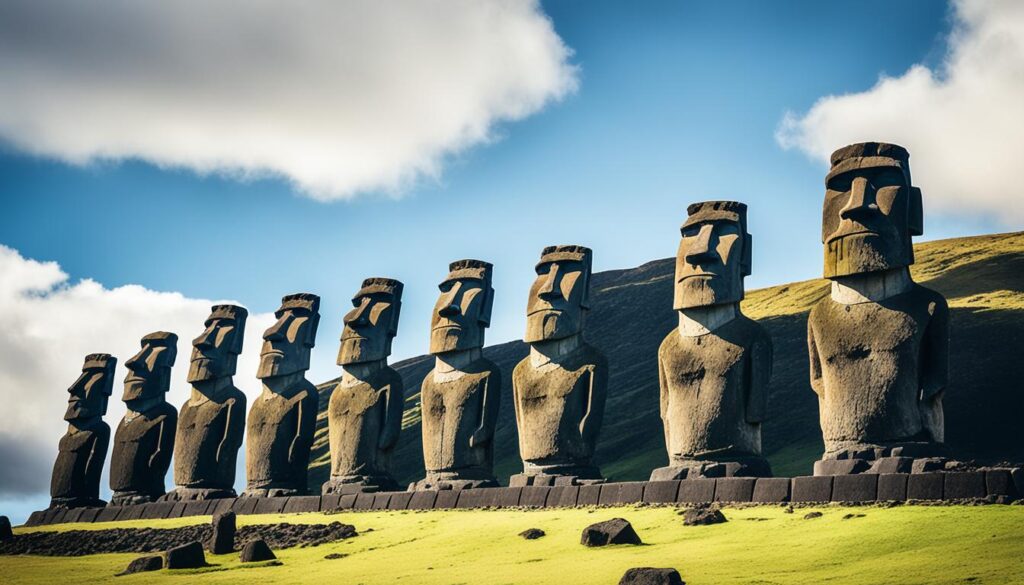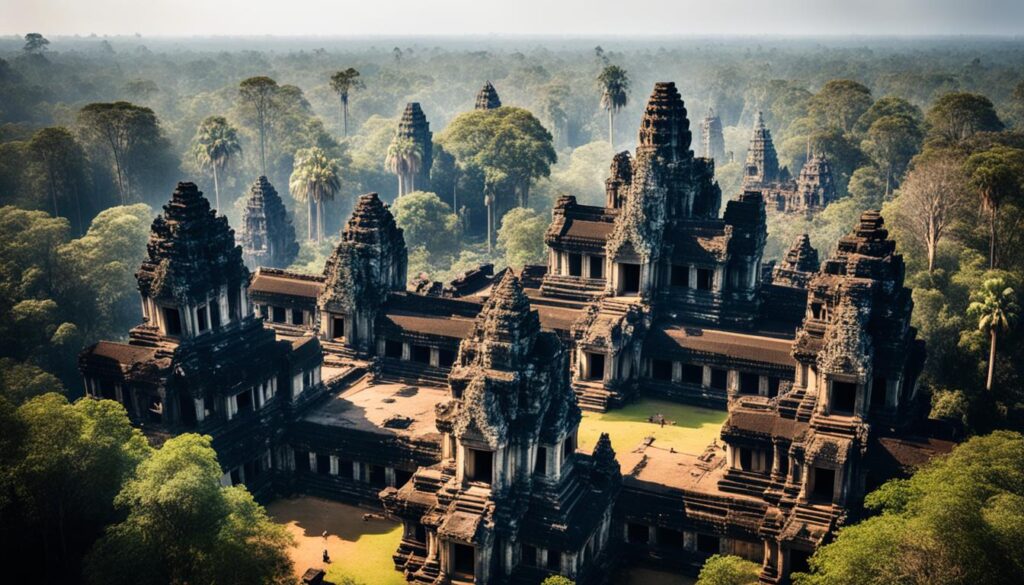Across the globe, ancient cultures still capture our imaginations. They leave us wondering about the ancient mysteries, lost civilizations, and historical enigmas. From the underwater city of Atlantis to the Nazca Lines, the world is full of unexplained phenomena and archaeological discoveries. These mysteries challenge our understanding of the past.
Get ready to have your view of history changed as we explore these vanished cultures. We’ll dive deep into their secrets and shed light on the historical enigmas that puzzle scholars and adventurers. Join us to learn the truth behind the legends and the stories lost to time.
The Baffling Remnants of Atlantis
Atlantis, a lost continent, has fascinated people for thousands of years. It’s a mystery that has sparked endless debates. Scholars and researchers wonder if it was real or just a myth.
Plato’s Fabled Utopia: Fact or Fiction?
The ancient Greek philosopher Plato first wrote about Atlantis. He described it as a rich island-nation that existed long ago. It was said to be very advanced and wealthy, but it sank into the sea.
Uncovering the Underwater Ruins of a Lost World
Ever since, people have been searching for Atlantis. Explorers, archaeologists, and adventurers have looked for signs of it. They’ve found some underwater structures and artifacts that might link to Atlantis.
The search for Atlantis keeps going, making it even more intriguing. Finding out about this lost world is a dream for many. It keeps the story of Atlantis alive and exciting.
Unusual Facts: The Mystifying Nazca Lines
In the Peruvian desert, the Nazca Lines have amazed people for years. These huge ancient drawings show shapes and animals. They were made long ago by the Nazca people. The Nazca Lines are so big and precise, they still puzzle us today.
The Nazca Lines cover miles of desert. They are huge drawings on the ground. From the sky, you can see animals and shapes that are hard to believe.
People have many ideas about why the Nazca Lines were made. Some think they were for religious art or ceremonies. Others believe they might be an ancient calendar or messages to the gods. The Nazca Lines show amazing skill and planning.
Even after years of study, we still don’t fully understand the Nazca Lines. These ancient drawings amaze and puzzle us. They show how smart and hardworking the Nazca people were.
Uncovering the Enigmatic Moai of Easter Island
The Moai statues on Easter Island are a wonder. They show the skill of the island’s long-lost people. These huge stone figures were made from Easter Island’s volcanic rock. They have always fascinated people, making them try to figure out how they were made and why.
The Moai statues are huge, some as tall as over 30 feet. The Rapa Nui people, a Polynesian group, made them. They were very heavy, up to 80 tons, and were moved and placed all over the island. They showed the spiritual and cultural beliefs of their makers.

Colossal Stone Statues: A Testament to a Vanished Civilization
The Moai statues have always caught people’s attention. This has led to many theories about what they mean and what happened to the Rapa Nui people. Archaeologists are still learning about this lost society. They are finding out about their social life, religious beliefs, and how they moved these huge statues.
Scientists are still studying Easter Island and the Moai. These statues remind us of the Rapa Nui people’s legacy. They show how humans can be innovative, strong, and leave a lasting mark, even when things are tough.
The Elusive City of El Dorado
The story of El Dorado has been a dream for explorers and adventurers for many years. It’s said to be a land full of wealth and beauty, hidden deep in the Amazon rainforest. Many Spanish conquistadors and brave explorers have tried to find it.
The story of El Dorado comes from South American myths. It tells of a king who wore gold dust and ruled over a city of endless riches. This tale caught the attention of early European settlers. It made them dream of finding the lost city of El Dorado, known as the “golden one.”
Legends of a Golden Metropolis Fuel Explorers’ Dreams
For centuries, many have set out to find El Dorado. But no one knows exactly where it is. Famous explorers like Francisco de Orellana and Gonzalo Pizarro were among those who searched for it. They were driven by the hope of finding a golden paradise.
Even though many have failed, the search for El Dorado keeps going. It makes people wonder if it was ever real or just a myth. The hunt for El Dorado is one of the most famous quests in history.
Unveiling the Secrets of Göbeklitepe
In southeastern Turkey, a site has been uncovering secrets that change how we see human history. Göbeklitepe, an ancient temple, is rewriting history. It shows us the amazing things our ancestors could do.
Found in the 1990s, Göbeklitepe amazed archaeologists with huge stone pillars. These pillars, up to 20 feet tall, have carvings of animals and symbols. This shows that the Neolithic people were more advanced than we thought.
Göbeklitepe’s size and details make us rethink when religion and complex societies started. It’s older than farming and cities by thousands of years. This means it challenges our old ideas about early human societies.
Discoveries at Göbeklitepe give us a peek into our Neolithic ancestors’ lives and beliefs. As we learn more, Göbeklitepe’s story will change how we see the beginning of human civilization. It shows the incredible skills of our ancestors.
The Vanished Khmer Empire of Angkor
The Angkor region in Cambodia was once the heart of the mighty Khmer Empire. This lost civilization left behind an awe-inspiring legacy of majestic temples. These architectural wonders, built centuries ago, have amazed the world with their unique mix of human skill and nature’s power.
Majestic Temples Reclaimed by Nature’s Embrace
The Angkor temple complexes, like the iconic Angkor Wat, were key to the powerful Khmer Empire from the 9th to 15th centuries. Over time, these amazing structures have been slowly taken over by the jungle. Now, towering trees and lush greenery cover the ancient stones.
Visiting the Angkor ruins today is a dreamlike experience. You walk through a world where human achievement and nature’s strength live together. The detailed carvings, grand staircases, and tall spires of the Khmer temples contrast with the greenery around them. This creates a stunning visual scene that still amazes scholars and tourists.

The Angkor Archaeological Park, a UNESCO World Heritage Site, shows the creativity and strength of the Khmer people. As researchers and preservationists uncover the secrets of this lost civilization, the Angkor temples remind us of the fleeting nature of human empires. They also show the power of nature to take back what was once its own.
Tracing the Footsteps of the Anasazi
In the American Southwest, the Anasazi, or Ancestral Puebloans, left a lasting mark. Their cliff dwellings still amaze us today. These people lived long ago and left behind a legacy that puzzles and fascinates us.
The Anasazi were skilled and built their homes into the sides of cliffs. These dwellings were in hard-to-reach spots. They were both homes and safe places for the Ancestral Puebloans.
Enigmatic Cliff Dwellings Shrouded in Mystery
But what’s a big mystery is why they left their homes. They vanished around the 13th century. Now, their dwellings stand as proof of their skill and architecture. Scholars have many theories about why they left, like environmental changes or social issues.
The cliff dwellings of the Anasazi show us their lives and traditions. Every detail, every carving, and every stone can teach us more about them. It’s like a puzzle waiting to be solved.
Today, people from all over come to see these dwellings. They are drawn to the Anasazi’s skill and strength. The Anasazi’s story reminds us of the mysteries still hidden in the American Southwest.
The Enigmatic Olmec Civilization
In the heart of ancient Mesoamerica, a civilization rose that deeply influenced later cultures. The Olmec, known as the “mother civilization,” has fascinated historians and archaeologists for years. Their mysterious legacy continues to intrigue us.
The Olmec civilization thrived in southern Mexico from 1500 to 400 BC. They are famous for their huge stone heads. These heads, up to 9 feet tall and weighing 40 tons, puzzle researchers. They wonder about the artistry and purpose behind these massive sculptures.
The Olmecs left a legacy of achievements that helped shape Mesoamerica. They were experts in architecture, farming, and social structures. They also made big strides in writing, math, and astronomy, showing a high level of culture.
Despite our knowledge, many Olmec mysteries remain. We still don’t know much about their origins, beliefs, or why they declined. These questions keep us guessing about this mysterious Mesoamerican culture.
Piecing Together the Puzzle of Rapa Nui
Rapa Nui, also known as Easter Island, is a Pacific island that has amazed people worldwide. It’s famous for its mysterious moai statues and the downfall of its ancient civilization. Through new research, we learn about the factors that led to its collapse. This helps us understand how human societies can fail due to environmental and resource issues.
The moai statues are a big part of the island’s mystery. These huge stone figures are a sign of the Rapa Nui people’s skill and culture. They show how this ancient society was able to create such massive works with simple tools. But, these same skills might have also led to their downfall.
Scientists look into how environmental damage, resource use, and societal collapse were linked on Rapa Nui. The island’s remote location and limited resources made it prone to human impact. The Rapa Nui people grew their population and needed more resources, leading to deforestation. This likely caused soil erosion, less food, and harm to the island’s ecosystem.






